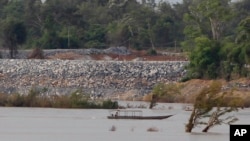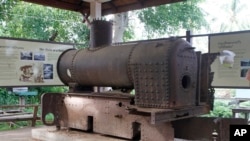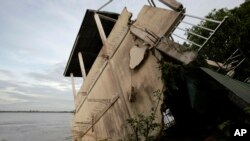At the forthcoming regional consultation forum on Laos’ Pak Beng hydropower dam in Luang Prabang, Cambodian environmental groups will urge relevant stakeholders, including the Cambodian government, to reject the 912-megawatt project, alarmed by the potential impacts on fisheries and sediment flow in the Mekong.
The two-day, February 22-23 forum organized by the Mekong River Commission (MRC), the only inter-governmental organization involved in managing the Mekong waterways, will be open for relevant stakeholders to share information and exchange views on the dam, according to an MRC announcement.
Pak Beng, a $1.88-billion dam about 1,540 kilometers (960 miles) from the Cambodia-Laos border, would be the third dam on the lower Mekong mainstream.
Laos’ controversial dams, the Xayaburi and Don Sahong near the border with Cambodia, have become a major concern for people living along the rivers.
In an interview with VOA Khmer, Tek Vannara, NGO Forum executive director, said that environmental groups would reject the dam, raising the expected serious impacts on Cambodia.
“They [Cambodian NGOs] don’t support the dam development. We don’t absolutely support the Pak Beng dam development,” Vannara said.
“Not only the Pak Beng dam, Laos will continue constructing more dams. They won’t stop.
“Therefore, the Mekong will not be a river for well-being and prosperity anymore. It will become the river of dams and controversies,” he said.
The NGO Forum plans to meet Cambodian government representatives who will join the forum a week prior to the meeting to discuss the concerns.
Vannara suggested alternatives for Laos to look at aside from constructing dams on Mekong River.
“If we look at Laos, it is mountainous, mostly. There are a lot of places to develop hydropower dams, why is it necessary in constructing dams on the mainstream of the Mekong River which causes controversies,” he said.
Laos, the only landlocked country in Southeast Asia, plans to develop more dams to profit from electricity exports.
The U.S.-based International Rivers group in January raised concerns over the dam.
“The Pak Beng Dam would have significant trans-boundary impacts on communities in Thailand and throughout the Mekong River Basin, compounding impacts from existing projects,” the release said.
It is expected that 25 villages in Laos and two villages in Thailand will be directly affected by construction of the Pak Beng Dam, with an estimated 6,700 people re-settled, according to International Rivers.
Sam Sovann, the executive director of Cambodia’s Northeastern Rural Development Organization, based in Kratie province next to the Laos border, said that the dam will affect Cambodian people living along the lower Mekong and Tonle Sap, in addition to the effects from the Dan Sahong and Xayaburi.
He called for the relevant partners to discuss the environmental impacts in detail.
“[There should be] more thorough talks [over the dam] in accordance with the 1995 Mekong agreement and analysis of the impacts on the environment, society, economics and human rights,” Sovann said.
“In the last few years, we see a lot of dam development in the Mekong Sub-Region, even Cambodia also has continuous dam studies,” he said.
Efforts to reach the Laos Embassy in Phnom Penh for comment were not successful.
Te Navuth, secretary general of the Cambodia National Mekong Committee, said that the Cambodia team will carry out an evaluation of the Pak Beng dam until May 2017 before forming a conclusion.
“We don’t have a clear stance yet since it is in the step of seeing the documents and evaluating,” Navuth said.
Under the 1995 Mekong agreement, a government seeking to build a dam on the Mekong must seek prior consultation and agreement with other members.
Navuth explained that under the agreement, all relevant countries have to follow a “compromise” process via evaluation, during which each country cannot accept or reject the plans.
Sao Sopheap, a spokesman for Cambodia’s Ministry of Environment, said that Cambodia needs to see an environmental impact assessment from Laos.
“We understand Laos’ need, but we also ask them to consider the environmental impacts on other Mekong countries, not only Cambodia, but also Vietnam,” he said.
Cambodia’s government recently agreed “in principle” to allow the Royal Group, chaired by tycoon Kith Meng, one of the country’s wealthiest businessmen, to study the feasibility of constructing three dams, including the massive 2,600-MW Sambor dam in Kratie province.
The government will balance the positive and negative impacts and weigh the effects against the need of electricity, Navuth said.
Nao Thuok, director of the Ministry of Agriculture’s Fisheries Department, said one of the dams, in Stung Treng province, could lead to a 20 percent drop in fish stocks.
“The important thing is to look for ways to mitigate it,” Thuok said.












